• Take a small amount of calcium oxide or quick lime in beaker.
• Slowly add water to this.

• Touch the beaker as shown in Fig.
Do you feel any change in temperature? Solution in Punjabi
Yes, its temperature has increased highly. following reaction takes place :
CaO+H2O+Ca(OH)2+Heat
Topper's Solved these Questions
- CHEMICAL REACTIONS AND EQUATIONSBOOK - NAND LAL PUBLICATIONCHAPTER - CHEMICAL REACTIONS AND EQUATIONSEXERCISE - ACTIVITY 1.5
1 Videos
- CHEMICAL REACTIONS AND EQUATIONSBOOK - NAND LAL PUBLICATIONCHAPTER - CHEMICAL REACTIONS AND EQUATIONSEXERCISE - ACTIVITY 1.6
1 Videos
- CHEMICAL REACTIONS AND EQUATIONSBOOK - NAND LAL PUBLICATIONCHAPTER - CHEMICAL REACTIONS AND EQUATIONSEXERCISE - ACTIVITY 1.3
2 Videos
- CARBON AND ITS COMPOUNDSBOOK - NAND LAL PUBLICATIONCHAPTER - CARBON AND ITS COMPOUNDSEXERCISE - ADDITIONAL QUESTIONS
3 Videos
- METALS AND NON-METALSBOOK - NAND LAL PUBLICATIONCHAPTER - METALS AND NON-METALSEXERCISE - ACTIVITY 3.8
3 Videos
Similar Questions
•Take about 2 g ferrous sulphate crystals in a dry bottle tube.
• Note the colour of the ferrous sulphate crystals.
• Heat the boiling tube over the flame of a burner or spirit lamp as shown in Fig.
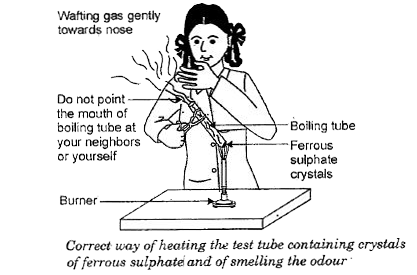
Observe the colour of the crystals after heating.
View Solution• Take about 2 g lead nitrate powder in a boiling tube.
• Hold the boiling tube with a pair of tongs and heat it over a flame,
What do you observe ? Note down the change, if any.
View Solution• Take a few zinc granules in a conical flask or a test tube.
• Add dilute hydrochloric acid or sulphuric acid to fig.
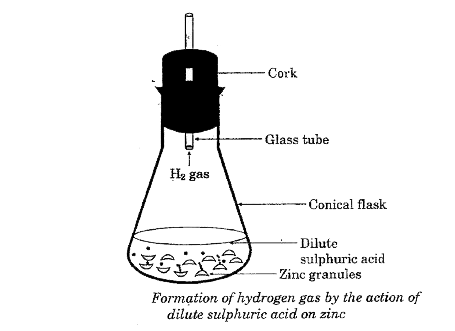
CAUTION : Handle the acid with care.
Do you observe anything happening around of zinc granules ?
View SolutionName the alcohol which constitutes glyceride.
View SolutionIs the product formed on burning magnesium acidic or basic?
View SolutionApparatus: Test tube, glass rod, beaker, Bunsen burner, etc. Chemicals: Hydrochloric acid, ammonia solution, magnesium strip, quick lime, etc. Activity 3: Take water in a beaker up to half of its capacity. Add a few pieces of quick lime (calcium oxide, CaO) to it. What will you observe?
View SolutionTake about 1 gm of calcium oxide in beaker and add 10 ml of water then, which of the following could be formed
View SolutionApparatus: Test tube, glass rod, beaker, Bunsen burner, etc.
Chemicals: Hydrochloric acid, ammonia solution, magnesium strip, quick lime, etc.
Activity 3: Take water in a beaker up to half of its capacity. Add a few pieces of quick lime (calcium oxide, CaO) to it. What will you observe?
View SolutionA small amount of quick lime is added to water in a beaker.
Name and define the type of reaction that has talen place.
View SolutionA small amount of quick lime is added to water in a beaker.
State two observations that you will make in the reaction.
View SolutionAim: To study the reaction between calcium oxide and water. Activity: Take some quick lime (Calcium oxide - CaO) in a beaker. Add water to it slowly. Touch the beaker as shown in the figure 1.3. What is formed by reaction of quick lime with water ? Write reaction.
View SolutionAim: To study the reaction between calcium oxide and water.
Activity:
Take some quick lime (Calcium oxide - CaO) in a beaker. Add water to it slowly.
Touch the beaker as shown in the figure 1.3.
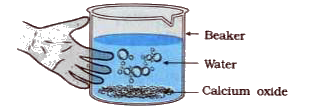
What is called the reaction occurring between quick lime and water ?
View SolutionAim: To study the reaction between calcium oxide and water.
Activity:
Take some quick lime (Calcium oxide - CaO) in a beaker. Add water to it slowly.
Touch the beaker as shown in the figure 1.3.
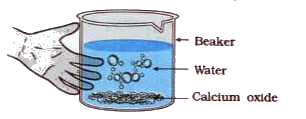
What do you feel by touching the beaker outside ?
View SolutionAim: To study the reaction between calcium oxide and water.
Activity:
Take some quick lime (Calcium oxide - CaO) in a beaker. Add water to it slowly.
Touch the beaker as shown in the figure 1.3.
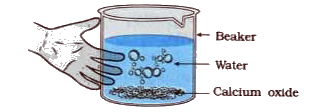
What is slaked lime ?
View SolutionApparatus: Test tube, glass rod, beaker, Bunsen burner, etc. Chemicals: Hydrochloric acid, ammonia solution, magnesium strip, quick lime, etc. Activity 3: Take water in a beaker up to half of its capacity. Add a few pieces of quick lime (calcium oxide, CaO) to it. What will you observe?
View Solution
